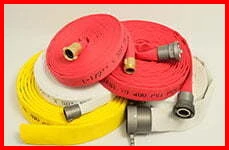Main Form Products > Hoses > Firefighting Hoses
Firefighting Hose Single-Jacket and Double-Jacket Layer - General Information
Firefighting Hose Single-Jacket and Double-Jacket Layer - General Information
Firehose Construction - Single Layer vs Double Layer
To understand how the two hose types differ, it helps to know how they are constructed. Single jacket hose and double jacket hose are made up of the same two components: The inner lining and the outer jacket(s). The inner lining in a modern fire hose is a single ply of EPDM rubber. The characteristics of EPDM rubber are its durability and resistance to chemicals. The rubber lining itself, although designed with a tensile strength of 1800 PSI, will not hold fluid pressure. Without a jacket, the tube itself would essentially blow up like a balloon and burst.
To create the hose assembly the linings are inserted and pulled through the jackets. They are then subjected to a steam vulcanizing process that bonds the jacket to the lining. The woven jacket consists of ring spun polyester yarns that are engineered to resist abrasion, mold, and mildew. The jackets are woven on large circular looms specific to the size of the fire hose they will ultimately become.
The jacket gives the hose its strength and pressure rating. While the majority of jacketed hose is white, there are also a variety of colors available. To achieve coloration, the jacket is impregnated with a dye, also known as hypalon coating.
The difference between single jacket and double jacket fire hoses is the number of polyester jackets. The double jacket hose has an extra layer of woven fabric that boasts a higher wearability in comparison to the single jacket hose. It has an impressive burst test of 1,200 PSI and a 400 PSI service test.
In comparison, a single jacket fire hose is burst tested to 900 PSI. In order to meet NFPA requirements, single jacket hose must be service tested annually to 300 PSI.
Single Vs Double Layer Practical Considerations
Although the double jacket hose is more costly than the single jacket, the extra layer helps protect it from burns, wear, and other damage. As a result, its service life is double that of its single jacket counterpart.
If you are not using the hose for a heavy-duty application, or if the need is temporary, you may choose the more economical single jacket hose. Single Jacket Firehose also a little lighter, which is important in situations when the hose must be carried - such as for forestry and wildland fires.
Types of Single Jacket Firehose
Rack and Reel Firehose
Rack and Reel Firehose is a single jacket hose manufactured to meet a specific application. Hospitals, airports, hotels, and other municipal or public buildings typically have these hoses pre-folded in a pin rack or cabinet for fire emergencies.
MSHA Hose for Mine Applications
MSHA (Mine Safety and Health Administration) approved hose is another type of single-jacketed hose. MSHA hose meets certain specifications and has the ability to self-extinguish when a flame source is removed. The lining of a MSHA hose is made of synthetic rubber, which does not produce toxic gases when ignited.
Mill Discharge
Mill Discharge hose is sometimes also called the contractor hose. The mill discharge hose is available in both single jacketed and double jacketed.
Though similarly constructed to regular single and double jacket hoses, these variations have a slightly lower pressure rating. Often times, construction sites, parks, or agriculturists will employ these hoses for undemanding purposes such as watering crops, draining a pond, or simply transferring water from point A to point B. (It is important to note that for washdown purposes, a rubber-covered hose is the way to go.)
Download Catalog Page (coming soon)



